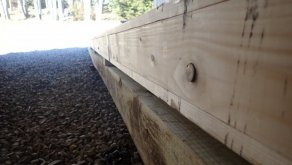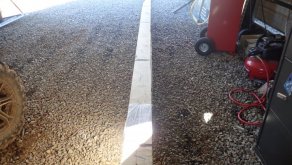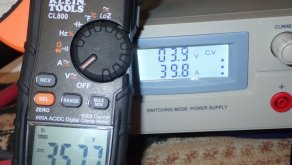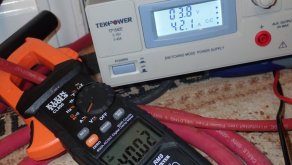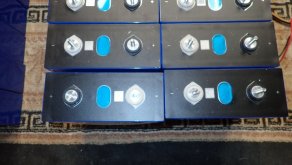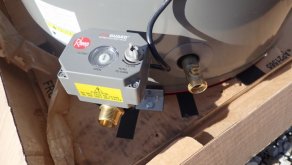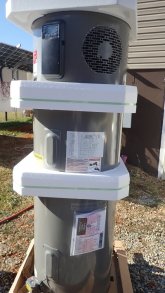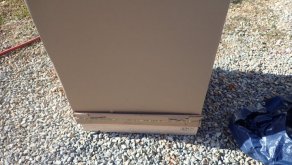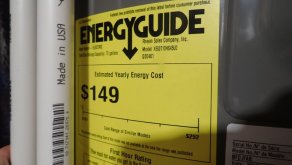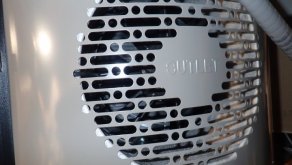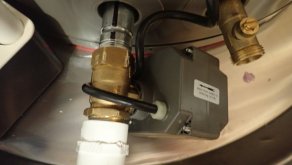I'm on the phone with tekpower now, while watching the charger which I had set at 3.5v via my volt meter it jumped to 4.7v. I can try and charge one but now I do not trust the charge the battery was at 3.71 but dropped down quickly.Either you have the worst luck of the forum with power supplies or you have some bad cells. I know you said you tested on individual batteries, but have you tried charging individual cells?
You are using an out of date browser. It may not display this or other websites correctly.
You should upgrade or use an alternative browser.
You should upgrade or use an alternative browser.
Very new to solar but started purchasing items, not sure of the final specs of the whole system.
- Thread starter kromc5
- Start date
I got it up and working it requires you to short the connections on the back of the power supply to adjust the current limiter which was not in the instructions. The tekpower was helpful getting me to the right resource but the tech was not very courteous concerning my lack of knowledge about this.
Using the 15v/40amp, at 3.597 volts it is at 35.6 amps. If you should decided to get one and the amperage is low, you have to short the back terminals. You want to adjust till you see 1volt then turn the current all the way up it that is desired and then disconnect the wire used to short. It is decently quite and not running warm at all.
I'm currently taking readings to try an esitmate the charge time, but so far it might be beneficial to purchase a second.
I'm currently taking readings to try an esitmate the charge time, but so far it might be beneficial to purchase a second.
I got it up and working it requires you to short the connections on the back of the power supply to adjust the current limiter which was not in the instructions. The tekpower was helpful getting me to the right resource but the tech was not very courteous concerning my lack of knowledge about this.
That's bizarre. If it wasn't in the manual, how would you have ever known that? I didn't see anything in the Amazon reviews about that.
Luckly for me the amazon rep was on the phone and I gave him a great review for backing me up and assisting, the tech was extremely unpleasant to work with. But I'm happy they are now up to 3.43v slowly but surely.That's bizarre. If it wasn't in the manual, how would you have ever known that? I didn't see anything in the Amazon reviews about that.
I contacted ground control, Major Tom said to abort the top balance. Last night was long wating for them to finish the top balance. I lined up the other 64 in anticipation of starting asap. I came down and noticed one was not even and is very swollen voltage is the same at the others at 3.338. I contacted the seller and will update on the response, I will also order some spares.
Attachments
So after top balancing all 64 cells settled to 3.631, so I started on the other 32. The one cell that blew up over night is still sitting at 3.338 and the internal resistance is unchanged. When I picked it up you can hear liquid inside, I found on the forums you can apply light pressure to deflate. I wonder what would cause this since it new and has not been charged? Would it be safe to try and deflate and has anyone ever heard liquid moving around in a battery?
After removing the bus bars from the 64 bank they were all at 3.631, I moved them over and stated the top balance on the 32. Just checked the voltages and I have a delta of 6.593 to 6.24 on the 64. I'm wondering with this much of a swing from low to high before building the 4p16s I would want to let them balance without assitance? My supplier is stating 2 months for any deliveries which is now more than double the first time. With this one battery swelling with no outside assistance it was a good wake up call that spares are definitely needed.
That picture is worth a thousand words. See the red banana jack there? And the black one right next to it, but not in the picture? That's where you plug in your meter and set it to 3.65 volts. Currently (in the picture) you have the supply set to charge to 3.9 volts, and as soon as the cells get full, it will overcharge the cells. Always set the voltage without a cell hooked up, then hook up a cell and turn up the amps. Resist the temptation to turn up the voltage so you can get more amps, you will overcharge. With a cell connected, you can't set the voltage correctly (although through those front jacks you can get close). No matter what you have the voltage set to, the cells will soak it up, and measuring at the cell just tells you how close you are to charged, it is not an accurate setting for the supply.Few picks of it up and running and the delta between the readout and meter:
The cell that expanded was never charged, I'm using the output on the back as the front jack is only for very low amperage output.That picture is worth a thousand words. See the red banana jack there? And the black one right next to it, but not in the picture? That's where you plug in your meter and set it to 3.65 volts. Currently (in the picture) you have the supply set to charge to 3.9 volts, and as soon as the cells get full, it will overcharge the cells. Always set the voltage without a cell hooked up, then hook up a cell and turn up the amps. Resist the temptation to turn up the voltage so you can get more amps, you will overcharge. With a cell connected, you can't set the voltage correctly (although through those front jacks you can get close). No matter what you have the voltage set to, the cells will soak it up, and measuring at the cell just tells you how close you are to charged, it is not an accurate setting for the supply.
Ampster
Renewable Energy Hobbyist
Two of my bloated cell experiences were the result of over discharge not over charging. One was with LFP and the other with NMC Nissan Leaf modules.The cell that expanded was never charged,
I have no way to discarge the batteries it was just sitting in line with the other 64 till I finished the top balance. It's also at the same voltage as the other 64 that have not been top balanced.Two of my bloated cell experiences were the result of over discharge not over charging. One was with LFP and the other with NMC Nissan Leaf modules.
The jacks in the front are connected to the output of the power supply by about 3 inches of 14 gauge wire. The outputs on the back are connected by what looks like the metric equivalent of 10 gauge wire. The only difference between the front and the back jacks is wire size and length, there is nothing restricting you from pulling more amps except the wire capacity (i.e. there is no current limiting circuitry). They are very convenient to use with a meter. I am just trying to explain how not to overcharge cells by accident, a common mistake is to jack up the voltage to enable higher amps, unless you literally watch it like a hawk, once the cell voltage hits 3.4 to 3.5 volts, you can overcharge a cell within 10 or 15 minutes with a 40 or 60 amp charger that has the voltage increased to allow it to pump out those amps. The drop in amps put out is totally ok, ohms law explains it well and is not a sign the power supply is defective, quite the opposite.The cell that expanded was never charged, I'm using the output on the back as the front jack is only for very low amperage output.
The jacks in the front are connected to the output of the power supply by about 3 inches of 14 gauge wire. The outputs on the back are connected by what looks like the metric equivalent of 10 gauge wire. The only difference between the front and the back jacks is wire size and length, there is nothing restricting you from pulling more amps except the wire capacity (i.e. there is no current limiting circuitry). They are very convenient to use with a meter. I am just trying to explain how not to overcharge cells by accident, a common mistake is to jack up the voltage to enable higher amps, unless you literally watch it like a hawk, once the cell voltage hits 3.4 to 3.5 volts, you can overcharge a cell within 10 or 15 minutes with a 40 or 60 amp charger that has the voltage increased to allow it to pump out those amps. The drop in amps put out is totally ok, ohms law explains it well and is not a sign the power supply is defective, quite the opposite.
I completed the first 64 with no issues, there is a large delta from what is shown to what the actual output is. From the front to the back you have a 1.2 to 1.4v delta. I would think a common mistake would have been for some to turn up the the voltage and not pay attention to when it stops. Throughout the charging I would adjust the voltage till it stopped then backed it down by .5 this kept it from running away and was very stable during the top balance on the first 64. I was up till almost 3:00am monitoring the batteries on the final leg. This battery that swelled was not charged or discharged it was merely in a bank of 64 wating to be top charged.
Ampster
Renewable Energy Hobbyist
I once had a cell get warm when in a parallel group that I was assembling for parallel top balancing. It turns out that I had polarity wrong. The other possibility is that it was a bad cell that got charged by being in parallel. Possibly an internal short?This battery that swelled was not charged or discharged it was merely in a bank of 64 wating to be top charged.
Unfortantely there is a common habit in the ID population and I beleive that we are now at point were we could save dramatically heating water. We have been averaging 3 loads per day not including myself or wife. I had not planned on this but with almost 30% off it was a great savings.
Attachments
I find it very quite, I measured just slightly over 12amps which is the spec.
All connections are marked and pre-installed but the bottom was leaking heavily, as you can see by the factory black line I had to turn a long ways to get it to stop. I will contact RHEEM and provide feedback on what they say about it. Installation was very easy besides the one leak and the leak sensor is extremely accurate. Per local law we have to keep the water at 110f, the federal has mandated 129f min, our previous water heater I had to physical break the protection tabs to turn below 120f. I was very happy when I found out it could indeed be set lower than the federal mandate.
All connections are marked and pre-installed but the bottom was leaking heavily, as you can see by the factory black line I had to turn a long ways to get it to stop. I will contact RHEEM and provide feedback on what they say about it. Installation was very easy besides the one leak and the leak sensor is extremely accurate. Per local law we have to keep the water at 110f, the federal has mandated 129f min, our previous water heater I had to physical break the protection tabs to turn below 120f. I was very happy when I found out it could indeed be set lower than the federal mandate.
Attachments
Last edited:
I had not paralleled them yet, that evening I had just finished the 64 and was going to pull the buss bars and move them over when I noticed the cell was not close the the others. I just took a video and uploaded for the seller, I can hear a substantial amount of liquid in it when moving it. I thought when I went to test the voltage would have been way down or resistance way up but neither. I had lined them up while watching the last bit of top balance on the 64 bank, its a mystery to me as the most probable is over/under charge but if you look back the bus bars were still on the first bank, I only have enough to do 64 at time.I once had a cell get warm when in a parallel group that I was assembling for parallel top balancing. It turns out that I had polarity wrong. The other possibility is that it was a bad cell that got charged by being in parallel. Possibly an internal short?
Similar threads
- Replies
- 52
- Views
- 4K



